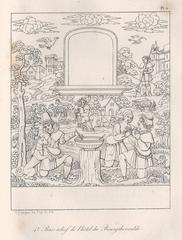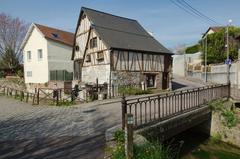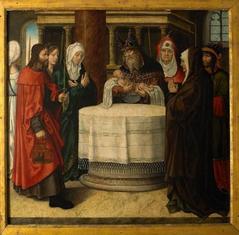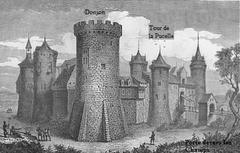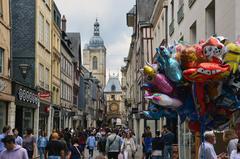Église Saint-Patrice de Rouen: Visiting Hours, Tickets, History, and Significance
Date: 04/07/2025
Introduction
Église Saint-Patrice de Rouen, gracefully situated in Rouen’s historic heart, stands as both an architectural gem and a living testament to Normandy’s deep medieval and Renaissance heritage. Dedicated to Saint Patrick—the patron saint of Ireland—this church reflects Rouen’s cosmopolitan past and its role as a vibrant medieval trading hub. With origins in the 10th century and a current structure largely rebuilt in the 16th century following a devastating fire, Église Saint-Patrice is celebrated for its flamboyant Gothic and early Renaissance architecture, remarkable stained glass windows, and profound community significance. This guide provides essential information on visiting hours, admission, accessibility, highlights, and the church’s historical and cultural role, ensuring a rewarding visit to this treasured Rouen landmark (Rouen Histoire; Patrimoine-Histoire; Eglise.City).
Historical Overview
Early Foundations and Medieval Rebuilding
The earliest church on this site dates back to the 10th century, originally an oratory outside Rouen’s medieval walls. Its dedication to Saint Patrick alludes to the city’s commercial connections with Ireland, underlining Rouen’s cosmopolitan character. After a catastrophic fire in 1228, the church was rebuilt and incorporated within the new city ramparts, marking its transition from peripheral to central importance (Rouen Histoire).
Renaissance Reconstruction and Architectural Flourishing
In the 16th century, Église Saint-Patrice underwent a major transformation, culminating in 1535 with the construction of its flamboyant Gothic structure—distinguished by intricate stonework, pointed arches, and a striking trident-shaped plan. Later additions in the 17th century, including a quadrangular bell tower with Corinthian capitals, enhanced its architectural prominence (Patrimoine-Histoire).
Social, Religious, and Artistic Significance
From the 16th century onward, Saint-Patrice became a prestigious parish favored by Rouen’s elite, notably members of the Parlement of Normandy. It hosted the Confrérie de la Passion, renowned for its religious theater “Mystères.” The church endured turbulence during the Wars of Religion, the French Revolution, and periods of closure, but was consistently restored to its Catholic function, demonstrating resilience and community importance (Rouen Histoire).
A highlight of the church is its extraordinary stained glass collection, dating from the 15th through 17th centuries, with later additions including a modern window by Max Ingrand. These windows, along with historic organs and Renaissance furnishings, make Saint-Patrice a showcase of Rouen’s artistic heritage (Patrimoine-Histoire; France-Voyage).
Architectural Highlights
Exterior and Façade
The church’s west façade, rebuilt in the 19th century by architect Eugène Barthélemy, features a richly sculpted tympanum depicting scenes from Saint Patrick’s life. The 17th-century bell tower, with its classical Corinthian capitals, exemplifies the blend of Gothic and Renaissance influences (Patrimoine-Histoire).
Layout and Interior
Église Saint-Patrice is constructed on a Latin cross plan, with a central nave and two side aisles, each doubled by chapels at the choir. The interior is characterized by round pillars, ribbed vaulting installed during 19th-century restorations, and a harmonious blend of space and light (POP Culture Gouv).
Stained Glass Windows
The church’s stained glass is among the finest in Normandy. The windows, created between the 15th and 17th centuries, narrate biblical stories and lives of saints in vivid color. Notable pieces include the “Verrière des Saints et de la Vierge” and windows transferred from the former Église Saint-Godard. The collection is classified into medieval, Renaissance, and modern groups, with some panels now housed in international museums (France-Voyage).
Artistic Furnishings
The church houses exceptional liturgical art: Renaissance statues, altarpieces, a historic organ (built in 1662), and paintings by artists such as Martin de Vos. Many furnishings were acquired during the Revolution from other Rouen churches, further enriching its interior (Monumentum).
Chapels and Tower
The north and south choir chapels—dedicated to the Virgin and Saint Joseph—were built in the 16th and 17th centuries. The bell tower, damaged during the 16th-century wars, was restored and stands as a rare example of classical detail within a Gothic ensemble (Patrimoine-Histoire).
Restoration and Conservation
Église Saint-Patrice has been the focus of major restoration, most notably in the 19th century and following structural issues discovered in 2025. Emergency stabilization and further vault repairs are underway, underscoring the church’s status as a protected Monument Historique (Actu.fr; Monumentum).
Liturgical Life
The church is actively used for worship, with the Institut du Christ Roi Souverain Prêtre regularly celebrating the traditional Latin rite. The space is also a venue for organ concerts, choral performances, and community events (ICRSP Rouen).
Practical Information for Visitors
Location and Access
- Address: 1 Rue Abbé Cochet, 76000 Rouen, France
- Neighborhood: Located in Rouen’s historic center, close to major attractions like Gros-Horloge and Place du Vieux-Marché (eglise.city).
- Public Transport: Tram stop “Palais de Justice” (400m away); several bus lines serve nearby stops.
- Parking: Public garages such as Parking Vieux-Marché and Parking Palais de Justice are close by.
Visiting Hours
- Standard Hours: Monday to Saturday, 9:00 AM–6:00 PM; Sunday, 10:00 AM–1:00 PM and 3:00 PM–6:00 PM.
- Variations: Hours may change for holidays or special events. Always confirm with the official tourism page or parish (Rouen Tourisme).
Admission and Tickets
- Admission: Free for all visitors. Donations are welcomed to support preservation.
- Guided Tours: Available by arrangement through the parish or local tourism offices. Special events or group tours may require booking.
Accessibility
- Mobility: Main entrance is at street level; some chapels may have limited access due to historic features.
- Facilities: No dedicated accessible restrooms on site, but public facilities are available nearby. Contact the parish for assistance with special needs.
Mass Times and Religious Services
- Regular Masses: Including traditional Latin Masses; see official diocesan schedule or call +33 7 88 24 99 06 for current times.
- Major Celebrations: Feast of Saint Patrick (March 17), Easter, and other liturgical feasts feature special services and processions (horairedesmesses.com).
Nearby Attractions
- Rouen Cathedral
- Gros-Horloge
- Saint-Ouen Church
- Joan of Arc Historial All attractions are within a 10-minute walk, making Église Saint-Patrice an ideal starting point for exploring Rouen’s heritage.
Visitor Experience and Travel Tips
- Photography: Permitted for personal use (no flash); the stained glass is particularly photogenic on sunny days.
- Quiet Times: Weekday mornings and early afternoons are best for avoiding crowds.
- Walking Tours: Many guided city tours include Église Saint-Patrice, especially those focused on Rouen’s stained glass heritage.
- Safety and Comfort: Wear comfortable shoes to explore the historic district’s cobbled streets.
Cultural and Religious Role
Église Saint-Patrice is more than a monument; it remains a hub for community worship, cultural events, and charitable outreach. The church’s artistic treasures—especially its stained glass—serve as visual catechisms, while its liturgical and social activities anchor the neighborhood’s identity. During the annual feast of Saint Patrick and European Heritage Days, the church hosts special liturgies, concerts, and guided tours (Rouen Tourisme). Its openness and centrality make it a welcoming site for spiritual reflection and cultural discovery.
Frequently Asked Questions (FAQ)
Is there an entrance fee?
No, entry is free; donations are appreciated.
Are guided tours available?
Yes, book through the parish or local tourism office.
Is the church accessible for visitors with disabilities?
Main entrance is accessible; some areas may have limited access due to historic architecture.
What are the best times to visit?
Weekday mornings and early afternoons are least crowded.
Can I take photographs inside?
Yes, but please avoid flash and be respectful during services.
Are there special events?
Major celebrations include Saint Patrick’s Day and Easter, with special liturgies and processions.
Suggested Visuals and Media
Include high-quality images of the stained glass, nave, and exterior façade. Use descriptive alt tags such as “Église Saint-Patrice stained glass windows” and “Rouen historical church interior.” Maps and links to virtual tours can further enhance your visit.
Related Articles
Contact and Official Information
- Address: 1 Rue Abbé Cochet, 76000 Rouen, France
- Telephone: +33 7 88 24 99 06
- Official Diocesan Website for Église Saint-Patrice
- Visitor Information Page
Plan Your Visit
Église Saint-Patrice de Rouen offers an enriching blend of history, artistry, and living tradition in the heart of Normandy. Whether you seek spiritual inspiration, architectural wonder, or a deeper understanding of Rouen’s past, Saint-Patrice is a must-see. For updates on hours, restoration, and events, consult official tourism sites or the parish directly. Explore Rouen’s remarkable heritage and let Église Saint-Patrice be a highlight of your journey.
